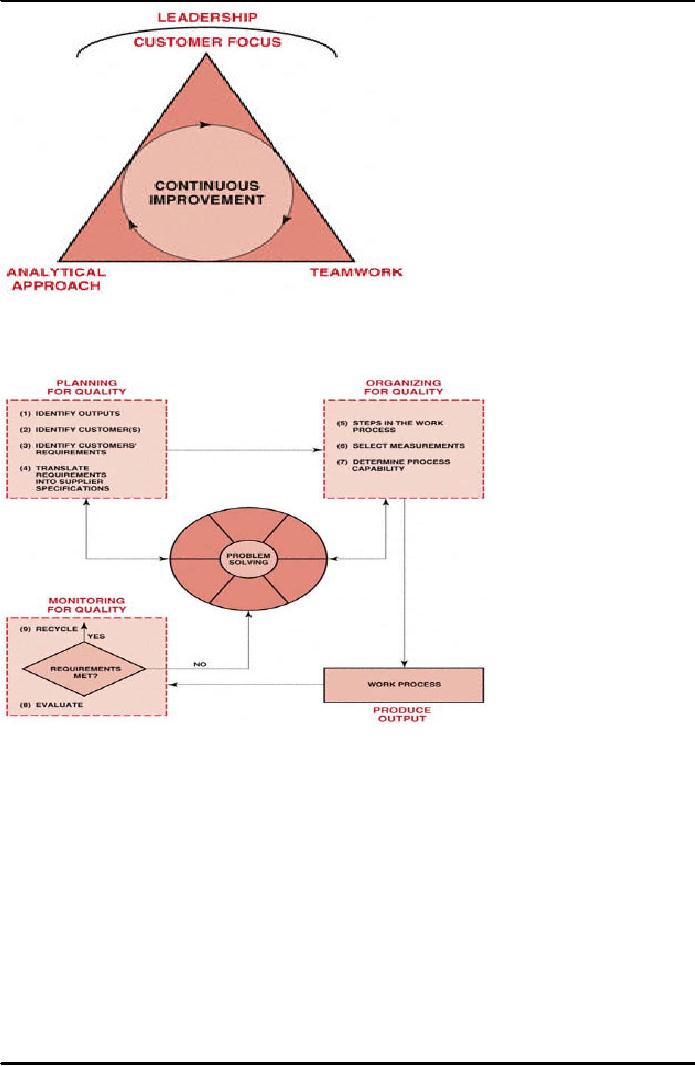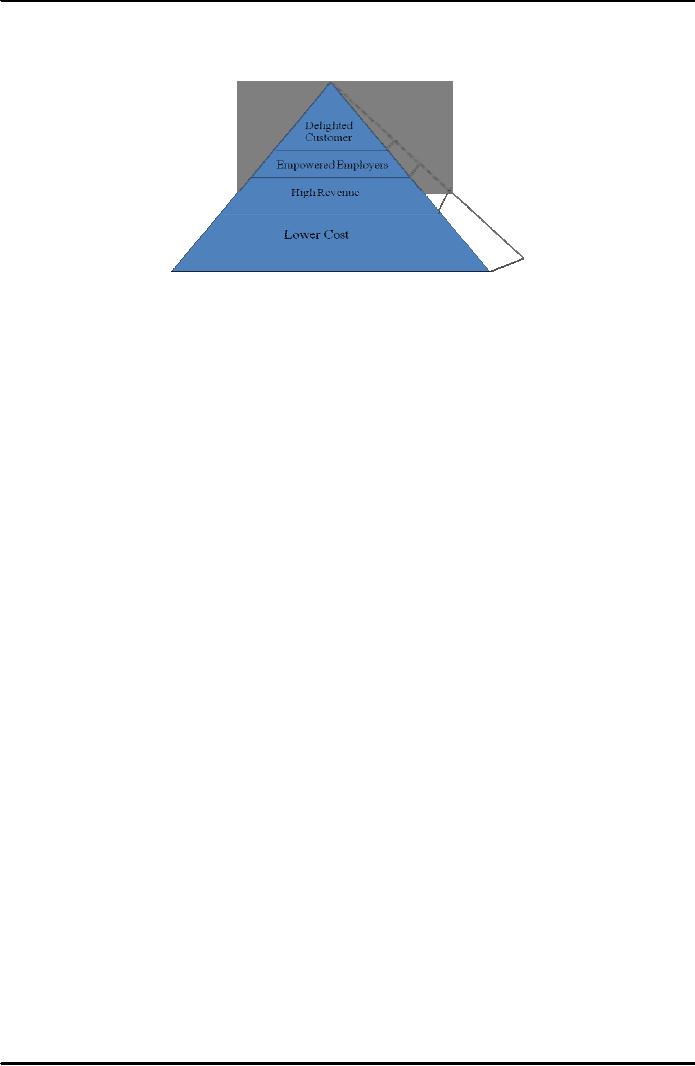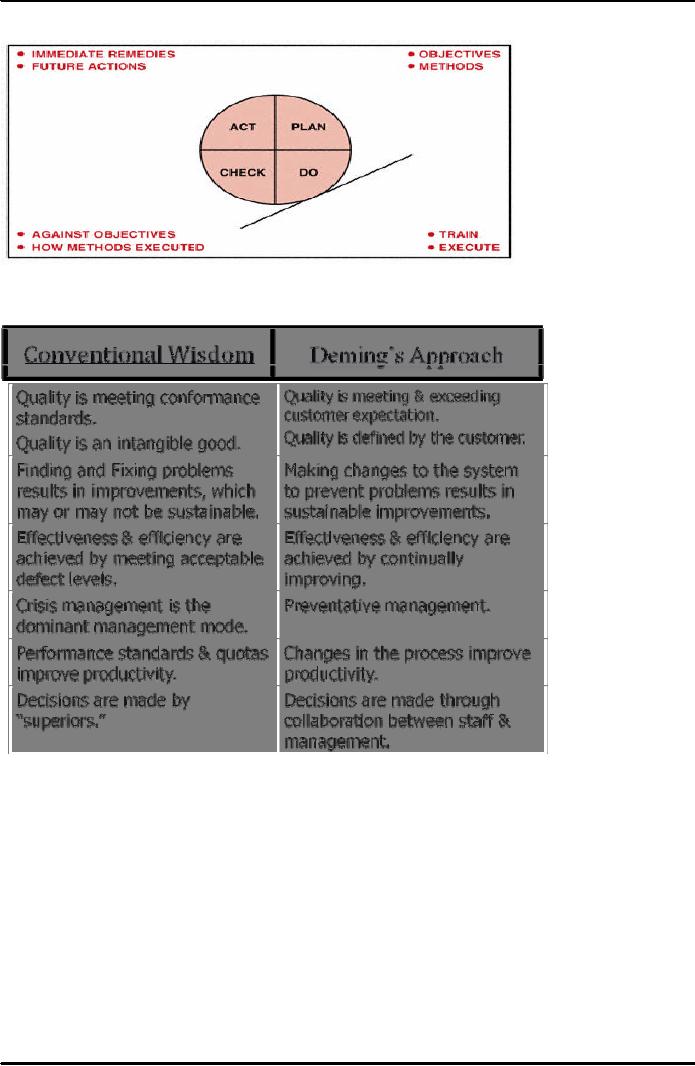 |

Project
Management MGMT627
VU
LESSON
35
QUALITY
IN PROJECT MANAGEMENT
(CONTD.)
BROAD
CONTENTS
The
Quality Movement
Quality
Development Stages
Quality
Audit
Deming
Philosophy
35.1
THE
QUALITY MOVEMENT:
During
the past 100 years, the
views of quality have changed
dramatically. Prior to World
War
I,
quality was viewed
predominantly as inspection, sorting
out the good items from the
bad.
Emphasis
was on problem identification.
Following World War I and up to the
early 1950s,
emphasis
was still on sorting good
items from bad.
However,
quality control principles were
now emerging in the form
of:
·
Statistical
and mathematical techniques
·
Sampling
tables
·
Process
control charts
From
the early 1950s to the late 1960s,
quality control evolved into
quality assurance, with
its
emphasis
on problem avoidance rather
than problem detection.
Additional quality
assurance
principles
emerged, such as:
·
The
cost of quality
·
Zero-defect
programs
·
Reliability
engineering
·
Total
quality control
35.2
DEVELOPMENT
OF QUALITY STAGES:
This
comprises of the following "five
level model":
1.
Inspection
2.
Quality
Control
3.
Quality
Assurance
4.
Quality
Management
5.
Total
Quality Management
1.
Inspection:
"Activity
such as measuring, examining, testing, or
gauging one or more
characteristics
of
an entity and comparing the
results with specified requirements in
order to establish
whether
conformity is achieved for each
characteristic" (ISO
8402)
2.
Quality
Control:
Quality
control is a collective term for
activities and techniques, within the
process, that
are
intended to create specific
quality characteristics. Such
activities include
continually
monitoring
processes, identifying and
eliminating problem causes,
use of statistical
255

Project
Management MGMT627
VU
process
control to reduce the variability
and to increase the efficiency of
processes.
Quality
control certifies that the
organization's quality objectives
are being met.
Quality
control is also referred to as the
technical aspect of quality
management. They
set
up the technical processes and
procedures that ensure that
each step of the
project
provides
a quality output from design and
development through implementation
and
maintenance.
Each step's output must
conform to the overall quality
standards and
quality
plans, thus ensuring that
quality is achieved.
A
good quality control system
will:
·
Select
what to control
·
Set
standards that provide the
basis for decisions regarding possible
corrective
action
·
Establish
the measurement methods
used
·
Compare
the actual results to the quality
standards
·
Act
to bring nonconforming processes and
material back to the standard based
on
the
information collected
·
Monitor
and calibrate measuring devices
·
Include
detailed documentation for
all processes
3.
Quality
Assurance:
Quality
assurance is the collective term
for the formal activities and
managerial
processes
that are planned and
undertaken in an attempt to ensure that
products and
services
that are delivered are at
the required quality level.
Quality assurance
also
includes
efforts external to these
processes that provide
information for improving
the
internal
processes. It is the quality assurance
function that attempts to
ensure that the
project
scope, cost, and time
functions are fully
integrated.
The
Project Management Institute
Guide to the Body of Knowledge
(PMBOK) refers to
quality
assurance as the management section of
quality management. This is the
area
where
the project manager can have the
greatest impact on the quality of
his project.
The
project manager needs to establish the
administrative processes and
procedures
necessary
to ensure and, often, prove
that the scope statement conforms to the
actual
requirements
of the customer. The project manager
must work with his
team to
determine
which processes they will
use to ensure that all
stakeholders have confidence
that
the quality activities will be
properly performed. All relevant
legal and regulatory
requirements
must also be met.
A
good quality assurance
system will:
·
Identify
objectives and
standards.
·
Be
multifunctional and prevention
oriented.
·
Plan
for collection and use of
data in a cycle of continuous
improvement.
·
Plan
for the establishment and maintenance of performance
measures.
·
Include
quality audits.
4.
Quality
Management:
During
the past twenty years, there
has been a revolution toward
improved quality. The
improvements
have occurred not only in product
quality, but also in quality
leadership
and
quality project management.
Unfortunately, it takes an economic
disaster or a
recession
to get management to recognize the need
for improved quality. Prior
to the
recession
of 19791982, Ford, General
Motors, and Chrysler viewed
each other as the
256

Project
Management MGMT627
VU
competition
rather than the Japanese. Prior to the
recession of 19891994,
high-tech
engineering
companies never fully recognized the
need for shortening
product
development
time and the relationship between project
management, total
quality
management,
and concurrent engineering. The push
for higher levels of quality
appears
to
be customer driven. Customers
are now demanding:
·
Higher
performance requirements
·
Faster
product development
·
Higher
technology levels
·
Materials
and processes pushed to the
limit
·
Lower
contractor profit margins
·
Fewer
defects/rejects
One
of the critical factors that can
affect quality is market expectations.
The variables
that
affect market expectations
include:
·
Salability:
the balance between quality and
cost
·
Produceability:
the ability to produce the product with
available technology
and
workers,
and at an acceptable
cost
·
Social
acceptability: the degree of conflict
between the product or process and
the
values
of society (i.e., safety,
environment)
·
Operability:
the degree to which a product
can be operated safely
·
Availability:
the probability that the product,
when used under given
conditions,
will
perform satisfactorily when
called upon
·
Reliability:
the probability of the product performing
without failure under
given
conditions
and for a set period of
time
·
Maintainability:
the ability of the product to be retained
in or restored to a
performance
level when prescribed maintenance is
performed
Customer
demands are now being
handled using total quality
management (TQM).
Total
quality management is an ever-improving
system for integrating
various
organizational
elements into the design, development,
and manufacturing efforts,
providing
cost-effective products or services that
are fully acceptable to the
ultimate
customer.
Externally, TQM is customer oriented and
provides for more
meaningful
customer
satisfaction. Internally, TQM reduces
production line bottlenecks
and
operating
costs, thus enhancing product
quality while improving
organizational morale.
5.
Total
Quality Management
(TQM):
For
this, we first explain what
"total
quality" is.
Total Quality means:
·
Quality
of work
·
Quality
of Service
·
Quality
of information
·
Quality
Process
·
Quality
of Organization
·
Quality
of People
·
Quality
of Company
·
Quality
of Objectives
Mature
organizations today readily
admit that they cannot accurately
define quality.
The
reason for this is because
quality is defined by the customer. The
Kodak definition
of
quality is those products and services
that are perceived to meet
or exceed the needs
and
expectations of the customer at a cost
that represents outstanding
value.
257

Project
Management MGMT627
VU
The
ISO 9000 definition is "the
totality of feature and characteristics
of a product or
service
that bears on its ability to
satisfy stated or implied needs."
Terms such as fitness
for
use, customer satisfaction,
and zero defects are goals
rather than definitions.
Most
organizations
today view quality more as a
process than a product. To be more
specific,
it
is a continuously improving process where
lessons learned are used to
enhance future
products
and services in order
to:
·
Retain
existing customers
·
Win
back lost customers
·
Win
new customers
Therefore,
companies today are
developing quality improvement
processes. Figure
35.1
shows
the five quality principles
that support Kodak's quality
policy. Figure 35.2
shows
a
more detailed quality improvement
process.
Total
Quality Management (TQM) is
a management strategy aimed at
embedding
awareness
of quality in all organizational
processes. Total Quality
Management (TQM)
has
been widely used in
manufacturing, education, government, and
service industries,
as
well as NASA space and
science programs.
Total
Quality provides an umbrella
under which everyone in the
organization can
strive
and
create customer satisfaction at
continually lower real
costs.
Total
Quality Management (TQM) is the
management of total quality. We
know that
management
consists of planning, organizing,
directing, control, and assurance.
Then,
one
has to define "total
quality". Total quality is
called total
because
it consists of the
following
three qualities:
1.
Quality
of
return to satisfy the needs of the
shareholders
2.
Quality
of
products and services to satisfy some
specific needs of the
consumer
(end
user)
3.
Quality
of
life - at work and outside
work - to satisfy the needs of the
people in the
organization.
This
is achieved with the help of upstream and
downstream partners of the enterprise.
To
this, we have to add the corporate
citizenship, that is the
social,
technological,
economical,
political, and ecological (STEPE)
responsibility
of the enterprise
concerning
its internal (its people)
and external (upstream and downstream)
partners,
and
community. Therefore, total
quality management goes well
beyond satisfying the
customer,
or merely offering quality products
(goods and/or services). Note
that we use
the
term consumer or end customer. The reason
is that in a Supply Chain
Management
approach,
we do not have to satisfy our
customers' needs but the
needs of our
customers'
customers' all the way to
the end customer, the consumer of a
product and/or
service.
258

Project
Management MGMT627
VU
Figure
35.1: Kodak's
Five Quality
Principles
Figure
35.2: The
Quality Improvement
Process
These
two figures (35.1 and
35.2) seem to illustrate
that organizations are
placing more emphasis on the
quality
process than on the quality
product and, therefore, are
actively pursuing quality
improvements
through
a continuous cycle.
35.3
QUALITY
AUDIT:
A
quality audit is an independent
evaluation performed by qualified
personnel that ensures
that
the
project is conforming to the project's
quality requirements and is following the
established
quality
procedures and policies.
A
good quality audit will
ensure that:
·
The
planned quality for the
project will be met.
·
The
products are safe and fit
for use.
·
All
pertinent laws and regulations are
followed.
·
Data
collection and distribution systems
are accurate and
adequate.
259

Project
Management MGMT627
VU
·
Proper
corrective action is taken
when required.
·
Improvement
opportunities are
identified.
Figure
35.3: The
Result of Total Quality
35.4
DEMING'S
PHILOSOPHY:
Deming
postulated that 85 percent of all quality
problems required management to take
the
initiative
and change the process. Only 15 percent
of the quality problems could be
controlled
by
the workers on the floor. As an example,
the workers on the floor were
not at fault because
of
the poor quality of raw materials
that resulted from management's
decision to seek out
the
lowest
cost suppliers. Management had to change
the purchasing policies and
procedures.
Management
had to develop long-term relationships
with vendors.
·
Dr.
Deming's Dreadful
Diseases:
1.
Looking
elsewhere for examples, or concluding
that "our problems are
different.
2.
"Creative
accounting" rather than
"commitment"
3.
Purchasing
to an "acceptable level of
quality.
4.
Management's
failure to delegate
responsibility.
5.
That
employees cause all the problems.
6.
Quality
can be "assured by
inspection".
7.
False
starts: no organization-wide
commitment.
Although
many experts have contributed to the
success of the quality movement; the
three most
influential
contributors in this country and
internationally are W. Edwards Deming,
Joseph M.
Juran,
and Phillip B. Crosby. Dr.
Deming pioneered the use of
statistics and sampling
methods
from
1927 to 1940 at the U.S.
Department of agriculture. Dr.
Deming applied Dr.
Shewhart's
Plan/Do/Check/Act
cycle to clerical tasks.
Figure 35.4 shows the Deming
Cycle for
Improvement.
Deming
contended that workers simply cannot do
their best. They had to be shown
what
constitutes
acceptable quality and that
continuous improvement is not
only possible, but
necessary.
For this to be accomplished, workers
had to be trained in the use of
statistical process
control
charts. Realizing that even
training required management's
approval, Deming's lectures
became
more and more focused toward management
and what they must
do.
260

Project
Management MGMT627
VU
Figure
35.4: The
Deming Cycle for
Improvement
Table
35.1
261
Table of Contents:
- INTRODUCTION TO PROJECT MANAGEMENT:Broad Contents, Functions of Management
- CONCEPTS, DEFINITIONS AND NATURE OF PROJECTS:Why Projects are initiated?, Project Participants
- CONCEPTS OF PROJECT MANAGEMENT:THE PROJECT MANAGEMENT SYSTEM, Managerial Skills
- PROJECT MANAGEMENT METHODOLOGIES AND ORGANIZATIONAL STRUCTURES:Systems, Programs, and Projects
- PROJECT LIFE CYCLES:Conceptual Phase, Implementation Phase, Engineering Project
- THE PROJECT MANAGER:Team Building Skills, Conflict Resolution Skills, Organizing
- THE PROJECT MANAGER (CONTD.):Project Champions, Project Authority Breakdown
- PROJECT CONCEPTION AND PROJECT FEASIBILITY:Feasibility Analysis
- PROJECT FEASIBILITY (CONTD.):Scope of Feasibility Analysis, Project Impacts
- PROJECT FEASIBILITY (CONTD.):Operations and Production, Sales and Marketing
- PROJECT SELECTION:Modeling, The Operating Necessity, The Competitive Necessity
- PROJECT SELECTION (CONTD.):Payback Period, Internal Rate of Return (IRR)
- PROJECT PROPOSAL:Preparation for Future Proposal, Proposal Effort
- PROJECT PROPOSAL (CONTD.):Background on the Opportunity, Costs, Resources Required
- PROJECT PLANNING:Planning of Execution, Operations, Installation and Use
- PROJECT PLANNING (CONTD.):Outside Clients, Quality Control Planning
- PROJECT PLANNING (CONTD.):Elements of a Project Plan, Potential Problems
- PROJECT PLANNING (CONTD.):Sorting Out Project, Project Mission, Categories of Planning
- PROJECT PLANNING (CONTD.):Identifying Strategic Project Variables, Competitive Resources
- PROJECT PLANNING (CONTD.):Responsibilities of Key Players, Line manager will define
- PROJECT PLANNING (CONTD.):The Statement of Work (Sow)
- WORK BREAKDOWN STRUCTURE:Characteristics of Work Package
- WORK BREAKDOWN STRUCTURE:Why Do Plans Fail?
- SCHEDULES AND CHARTS:Master Production Scheduling, Program Plan
- TOTAL PROJECT PLANNING:Management Control, Project Fast-Tracking
- PROJECT SCOPE MANAGEMENT:Why is Scope Important?, Scope Management Plan
- PROJECT SCOPE MANAGEMENT:Project Scope Definition, Scope Change Control
- NETWORK SCHEDULING TECHNIQUES:Historical Evolution of Networks, Dummy Activities
- NETWORK SCHEDULING TECHNIQUES:Slack Time Calculation, Network Re-planning
- NETWORK SCHEDULING TECHNIQUES:Total PERT/CPM Planning, PERT/CPM Problem Areas
- PRICING AND ESTIMATION:GLOBAL PRICING STRATEGIES, TYPES OF ESTIMATES
- PRICING AND ESTIMATION (CONTD.):LABOR DISTRIBUTIONS, OVERHEAD RATES
- PRICING AND ESTIMATION (CONTD.):MATERIALS/SUPPORT COSTS, PRICING OUT THE WORK
- QUALITY IN PROJECT MANAGEMENT:Value-Based Perspective, Customer-Driven Quality
- QUALITY IN PROJECT MANAGEMENT (CONTD.):Total Quality Management
- PRINCIPLES OF TOTAL QUALITY:EMPOWERMENT, COST OF QUALITY
- CUSTOMER FOCUSED PROJECT MANAGEMENT:Threshold Attributes
- QUALITY IMPROVEMENT TOOLS:Data Tables, Identify the problem, Random method
- PROJECT EFFECTIVENESS THROUGH ENHANCED PRODUCTIVITY:Messages of Productivity, Productivity Improvement
- COST MANAGEMENT AND CONTROL IN PROJECTS:Project benefits, Understanding Control
- COST MANAGEMENT AND CONTROL IN PROJECTS:Variance, Depreciation
- PROJECT MANAGEMENT THROUGH LEADERSHIP:The Tasks of Leadership, The Job of a Leader
- COMMUNICATION IN THE PROJECT MANAGEMENT:Cost of Correspondence, CHANNEL
- PROJECT RISK MANAGEMENT:Components of Risk, Categories of Risk, Risk Planning
- PROJECT PROCUREMENT, CONTRACT MANAGEMENT, AND ETHICS IN PROJECT MANAGEMENT:Procurement Cycles